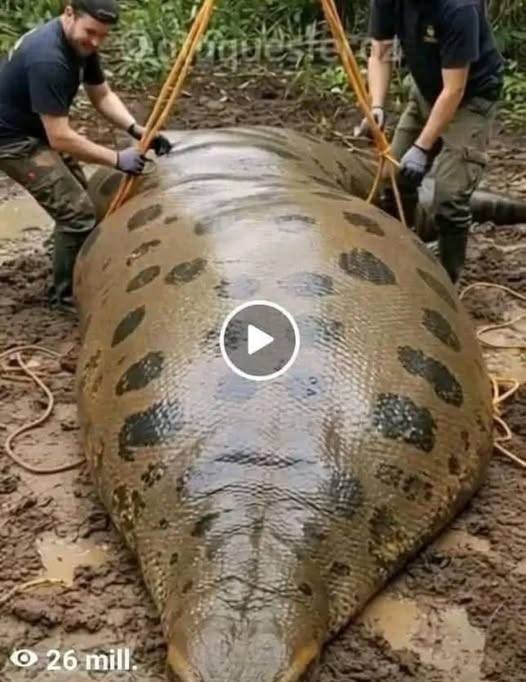
In recent weeks, a sensational story involving a giant snake and an alleged rescue has circulated widely across social media platforms and viral news websites. The headlines claimed that a woman had been discovered alive inside a massive snake in a Southeast Asian jungle—an account that seemed too extraordinary to be true. While such stories often generate immense public curiosity, it’s important to separate fiction from fact and explore the reality of snake behavior and human safety.
In this article, we aim to unpack the claims, review what is scientifically possible, and address public misconceptions regarding large snakes such as pythons and anacondas. All information provided here is based on verifiable data from reputable scientific institutions and wildlife experts.
The Origin of the Viral Story
The tale reportedly began in a remote area of Southeast Asia, where hikers allegedly encountered an unusually large snake exhibiting bloated abdominal movement. According to online claims, the group approached the reptile, examined its body, and found a living woman inside—injured but alive. Further unverified reports added that she had been abducted, drugged, and placed inside the snake as part of an alleged ritual by an unknown group.
Though gripping, there is no official confirmation or evidence to validate this story. To date, no reputable news organization, scientific authority, or law enforcement agency has confirmed such an incident. The viral versions lack crucial details such as names, locations, dates, and verified witness accounts—hallmarks of misinformation or urban legends.

Understanding Snake Behavior and Anatomy
To evaluate whether this event is scientifically possible, we must first understand the biology of large snakes.
1. Species Capable of Consuming Large Prey
Large snakes such as reticulated pythons (Python reticulatus), native to Southeast Asia, and green anacondas (Eunectes murinus), found in South America, are capable of consuming prey much larger than themselves due to their flexible jaw structure.
There are documented cases of large snakes swallowing animals such as deer, pigs, and even small crocodiles. In very rare circumstances, fatalities involving humans have occurred, but only after the person was fully subdued, typically through constriction, not ingestion while alive.
2. Can a Person Survive Inside a Snake?
The answer, from a biological and anatomical standpoint, is no. Once swallowed, a snake’s digestive process begins immediately. The environment inside a snake’s stomach is highly acidic (with a pH as low as 1), designed to break down bones, skin, and tissue efficiently.
The lack of oxygen, combined with the snake’s muscular pressure and digestive acids, would make survival inside the body impossible for more than a few minutes, let alone hours or days.

Real Cases vs. Internet Myths
While the viral tale bears similarities to real but rare fatal encounters between humans and snakes, such incidents are exceptionally uncommon and have never involved a person surviving inside a snake’s body.
Real-World Incident:
In 2017, a widely reported incident in Indonesia involved a 25-foot-long reticulated python that swallowed an adult man. The body was found inside the snake after it was cut open. However, this was a tragic fatality—not a miraculous survival.
Such stories often become exaggerated or transformed over time through repeated online sharing. The current viral version involving a woman’s rescue does not align with any verified event and appears to be a fictionalized account amplified for clicks.
The Dangers of Viral Misinformation
While tales like this may seem harmless or entertaining, they can contribute to the spread of fear, misunderstanding of wildlife, and sensationalism. More importantly, they divert attention from real issues in wildlife conservation, such as:
- Habitat loss affecting snake populations
- Human-animal conflict in rural regions
- Illegal wildlife trade
Responsible media consumption involves fact-checking and critical thinking. Always look for sources, official statements, and evidence before accepting or sharing such dramatic stories.
The Role of Cultural Myths
It is also worth noting that snakes play a significant role in folklore and mythology in many parts of the world. In some Southeast Asian cultures, snakes are revered or feared as symbols of power, rebirth, or danger. Stories of people encountering mystical snakes or surviving bizarre rituals may stem from these longstanding cultural narratives rather than actual events.
These mythologies are a valuable part of cultural history, but they should not be mistaken for scientific fact.
Conclusion: Reality Is Often Less Dramatic—But No Less Important
Although the viral tale of a woman surviving inside a snake makes for captivating storytelling, it is not supported by scientific evidence or confirmed reports. In reality, snakes do not and cannot shelter or transport living humans in the manner described.
Instead of focusing on sensationalized or fictionalized encounters, we encourage readers to explore the fascinating and real world of reptiles and wildlife. Education and awareness can foster respect for nature and reduce unnecessary fear or superstition.
Let this viral story be a reminder to always seek the truth—because reality, especially in the natural world, is already full of wonder.
References:
- National Geographic – “What Happens Inside a Snake When It Eats You?” https://www.nationalgeographic.com
- Smithsonian Magazine – “The Real Dangers of Giant Snakes” https://www.smithsonianmag.com
- Wildlife Conservation Society – Reports on Large Snake Behavior https://www.wcs.org
- BBC News – “Man Found Dead Inside Python in Indonesia” (2017) https://www.bbc.com/news/world-asia-40384106
- Journal of Herpetology – Studies on Snake Digestion and Anatomy https://www.jstor.org/journal/jherpetology
- CNN International – “Giant Snake Swallows Man Whole in Indonesia” https://edition.cnn.com
Would you like me to rewrite this into a shorter version for social media, or adapt it for video script or blog format?


